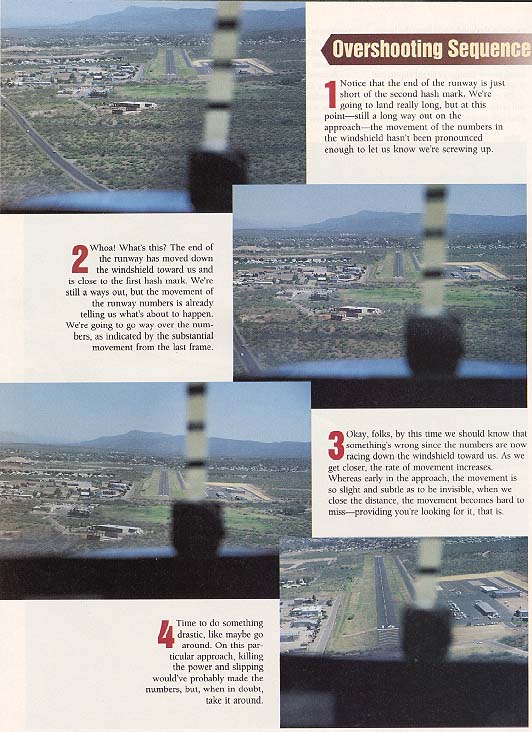

Aviation is up to its gunwales in rules of thumb. Some are obvious ("Never pass up a chance to get gas or visit a restroom") while others are less so ("The severity of swerves on landing are a function of the square of the ground speed). However, one of the most useful, while at the same time one of the most illusive is the old "If the numbers are coming at you, you're going to go over them. If they're goinga away you're going to be short." This last little homily is probably one of the most useful and is elegant in its simplicity. However, often much of what it is saying falls on deaf ears and unseeing eyes.
The concept of picking out exactly where your airplane is going to terminate it's glideslope if everything is left alone is something of a mystery to low time pilots. Sometimes it eludes higher time pilots, as well, simply because what is happening in the windshield has never been pointed out to them.
This entire visual glideslope reference concept is based on the fact that, all things being equal, the point where you'll hit the ground appears to remain stationary in the windshield. Everything in front of that point, which you'll over-fly on the way to the stationary touchdown point, appears to be moving towards you (moving down in the windshield). Everything on the other side, which you're not going to reach, appears to be moving away from you (moving up the windshield).
This sounds simple, right? And it is. Unfortunately, it is also one of those visual concepts that's similar to those weird pictures which are composed of a bizillion dots, but, if you look at them just right, you see the Mona Lisa or a buxom naked chick humping the shit out of some guy on a Harley (did I say that out loud??), or something. The instructor can solemnly intone, "See how the numbers are coming at you? That means you are going to be high..." a million times and the student just won't see it. They're trying, but they just can't see the movement. Then, all of a sudden, the lights come on and they exclaim, "...Hey, I see it. I really see it." For some, the lights never flicker on and they are still looking for "it."
The movement of the spot in the windshield can sometimes be very subtle, especially on long, low, flat approaches (which you shouldn't be making anyway). The shorter and steeper the approach, the more obvious the movement becomes.
It's probable that some pilots question whether it is important to see the movement of points in the windshield, in the first place. Others may ask, "...okay, I see the movement, so, now what?" The answer to that one is easy: knowing exactly where the airplane will touch down enables you to change the glideslope either through configuration changes, power or by using slips to put the airplane exactly where you want it. By being aware of exactly where, if you do nothing, you will land in relation to your intended point of touch down (the numbers, for instance), you can make what ever changes are necessary to put the airplane right on the spot.
It would be foolish to think that every approach is going to put the airplane right on the numbers, just as it would be foolish to think it's a good idea to always drag the approach out far enough that you have to use power to make it in, although that does guarantee you'll hit the mark (assuming the engine keeps running, that is). However, if working a short field, where putting right on the numbers is hyper critical, between the throttle and the ability to fine tune the approach at the last second with a slip, there is no excuse for not putting the airplane right on the intended spot. Not sort of on it, but right on it because of the visual references the moving point gives you in the windshield.
The basic rule of a short field approach is that the throttle follows the numbers. If the numbers are moving away from you and up the windshield, the throttle should follow them. If the numbers are coming at you and down the windshield, the throttle comes back. In the early part of the approach, the movement in the windshield will be subtle just as the throttle movements will be subtle. As you get closer, however, the apparent movements will become more pronounced which are telling you the throttle movements or other glideslope changes have to be just as pronounced. Ideally, however, if you've monitored the movements in the windshield from the beginning of the approach and adjusted accordingly, you won't be far enough off glideslope that you'll need more than a small power change or slight slip to put it where you want it.
Of course, aiding in the power control of the glideslope is the fact that you have gradually slowed the airplane to the recommended minimum shortfield approach speed (with an appropriate gust-buffer), which makes it more dependent on power and easier to control.
Because it's hard for some to visualize the movement of the points in the windshield, we decided to try and capture it on film. We put a segmented tape down the middle of the windshield and made several approaches, some intentionally high, some intentionally low, in an effort to dramatize the movement of the numbers in the windshield. While viewing the pictures, try to compensate for the fact that the poor old photographer (me) was getting his brains beat out by afternoon turbulence.


